影视人类学
影视人类学[1]
![影视人类学[1]](https://img.taocdn.com/s3/m/e4276c232af90242a895e53d.png)
影视人类学一、名词解释(本题共计20分,共计4小题,每题5分)1、影视人类学Visual anthropology,该术语出现于20世纪60年代晚期,是以人类学研究中影视手段的应用方式及其表现形式为研究对象,探讨影视手段在人类文化研究中的功能、性质、应用规律以及人类学片的特征、分类和制作方法的人类学分支学科。
2、人类学片是在人类学理论的指导下,综合运用人类学研究的科学方法和影视学的表现手段,对人类文化进行观察和研究,所取得成果的形象化表述。
3、追踪拍摄是一种追踪对象进行拍摄的方法,也叫作跟踪拍摄。
有两种情况,(1)带着拍摄的设备,随时准备拍摄;(2)选定特定的地点、时间和人群,进行定点跟踪调查。
4、复原拍摄是指对已经从现实中消失的文化现象,按其消失以前的本来面貌加以恢复进行拍摄,又称为“复原重建”。
基本要求有“实有其人,实有其事”。
二、列举(共计15分,共计3小题,每题5分)1、列举人类学片的多元功能⑴记录和保存人类文化;⑵研究价值和教育功能⑶艺术价值和审美价值;⑷文化传递与交流功能2、列举国际人类学电影节(至少5个)意大利国际民族学电影节、法国国际音像节、加拿大班佛山区文化电影节、大不列颠和爱尔兰皇家人类学研究院国际电影节、荷兰国际人类学电影节和阿姆斯特丹国际纪录片节3、列举中国民族志电影或民族志纪录片(至少5部)《不再裹小脚》、《弹棉花的人》、《卖报人》、《虎日》、《佤族》、《黎族》、《梁山彝族》、《最后的马帮》、《金凤花开》《三节草》《最后的山神》三、简答题(5分,任选2一题作答)1、请简答人类学片拍摄的原则和职业道德。
拍摄的原则:(1)直接形象性:不包括影视摄制者按创作需要设计出来的专供摄的人、事、物。
(2)科学真实性:一是科学真实、一是艺术真实(真实人物、真实事件、真实环境、真实内涵)(3)信息完整性:A、试听信息完整B、行为过程完整C、人物完整D关联或信息完整职业道德:①为了谁的利益进行拍摄和研究②以怎样的态度对待被拍摄者以及他们所属的群体③怎样保证被拍摄者的隐私权和经济利益不受侵犯2、请简单评述某部你看过的人类学纪录片。
《2024年影视人类学的脉络、路径和前瞻》范文

《影视人类学的脉络、路径和前瞻》篇一一、引言随着科技的不断进步,影视作品以其生动的视听体验成为了我们认识和理解人类文化、社会的重要媒介。
在这个大背景下,影视人类学逐渐崭露头角,为传统人类学注入了新的活力。
本文旨在梳理影视人类学的发展脉络,探讨其研究路径,并展望其未来前景。
二、影视人类学的脉络1. 起源与发展影视人类学起源于20世纪中叶的美国,当时电影和电视逐渐普及,人们开始尝试运用这些新兴的视听媒介来记录和传播人类文化。
随着技术的不断进步和人类学研究的深入,影视人类学逐渐发展成为一门独立的学科。
2. 国内外发展概况在国内,影视人类学的发展起步较晚,但近年来得到了迅速的发展。
许多学者开始尝试运用影视手段来记录和传播中国各地的传统文化,为保护和传承文化遗产做出了重要贡献。
国外影视人类学的发展则更为成熟,涵盖了全球各地的文化现象。
三、影视人类学的研究路径1. 理论框架影视人类学以人类学理论为基础,结合电影、电视等视听媒介的特点,形成了一套独特的理论框架。
它强调对人类文化的多元性、动态性和复杂性的认识,注重通过影像来展示和解读人类行为、信仰、价值观等文化现象。
2. 研究方法影视人类学的研究方法主要包括田野调查、影像记录、后期编辑等。
研究者需要深入实地,与当地人进行交流互动,了解他们的生活习俗、信仰观念等。
同时,还需要运用影像技术,将所观察到的人类行为、文化现象等记录下来,并进行后期编辑和解读。
3. 实践应用影视人类学的实践应用主要体现在文化传播、文化遗产保护等方面。
通过影像手段,可以将人类文化的多元性和复杂性呈现给观众,有助于增进人们对不同文化的理解和尊重。
同时,还可以为文化遗产的保护和传承提供重要的支持。
四、影视人类学的前瞻1. 技术发展随着科技的不断进步,影视人类学将更加注重运用先进的技术手段来提高影像的质量和传播效果。
例如,虚拟现实、增强现实等技术的应用将使观众更加深入地了解文化现象的背后含义。
2. 跨学科融合影视人类学将进一步加强与其他学科的融合,如心理学、社会学等。
《2024年影视人类学的脉络、路径和前瞻》范文
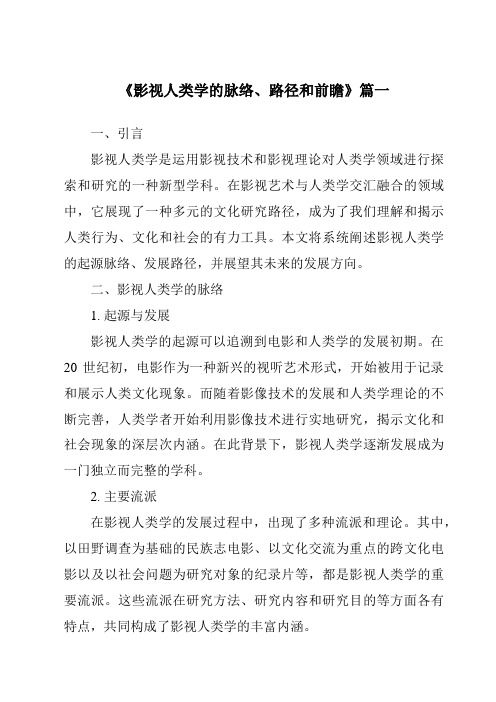
《影视人类学的脉络、路径和前瞻》篇一一、引言影视人类学是运用影视技术和影视理论对人类学领域进行探索和研究的一种新型学科。
在影视艺术与人类学交汇融合的领域中,它展现了一种多元的文化研究路径,成为了我们理解和揭示人类行为、文化和社会的有力工具。
本文将系统阐述影视人类学的起源脉络、发展路径,并展望其未来的发展方向。
二、影视人类学的脉络1. 起源与发展影视人类学的起源可以追溯到电影和人类学的发展初期。
在20世纪初,电影作为一种新兴的视听艺术形式,开始被用于记录和展示人类文化现象。
而随着影像技术的发展和人类学理论的不断完善,人类学者开始利用影像技术进行实地研究,揭示文化和社会现象的深层次内涵。
在此背景下,影视人类学逐渐发展成为一门独立而完整的学科。
2. 主要流派在影视人类学的发展过程中,出现了多种流派和理论。
其中,以田野调查为基础的民族志电影、以文化交流为重点的跨文化电影以及以社会问题为研究对象的纪录片等,都是影视人类学的重要流派。
这些流派在研究方法、研究内容和研究目的等方面各有特点,共同构成了影视人类学的丰富内涵。
三、影视人类学的路径1. 实地研究实地研究是影视人类学的基本路径之一。
通过深入实地,对特定文化和社会现象进行观察、记录和分析,影视人类学者能够更准确地捕捉和记录真实的文化场景和社会行为。
在这个过程中,他们可以运用摄影、摄像、访谈等多种手段,将文化和社会现象转化为生动的影像作品。
2. 跨文化交流跨文化交流是影视人类学的又一重要路径。
通过对比不同文化和社会背景下的行为和现象,影视人类学者可以揭示文化差异和文化交流的内在机制。
这种跨文化交流不仅有助于我们理解不同文化的特点和价值,还能促进不同文化之间的交流与融合。
四、影视人类学的前瞻1. 技术创新随着数字技术的不断发展,影视人类学将进一步拓宽其应用领域和技术手段。
例如,虚拟现实(VR)和增强现实(AR)技术可以为我们提供更加沉浸式的观察体验,无人机拍摄和无人机跟拍等新兴技术将为拍摄提供更多可能性和视角。
影视人类学

影视人类学影视人类学:珍贵的文化观察与传承影视人类学是研究电影和电视对于人类文化和社会影响的学科,通过观察和分析影视作品,揭示其中所蕴含的文化内涵和社会价值。
电影和电视作为现代人日常生活的重要组成部分,既反映了社会现象,又塑造着社会观念。
影视人类学通过深度解读电影和电视作品,提供了一个全新的角度来探索和理解人类文化。
影视作品是一种特殊的文化符号,不仅通过镜头语言传递信息,更通过影像和音频元素渗透到观众的感知中。
观众通过解码这些符号,与作品互动,进而产生共鸣和理解。
例如,古装剧是中国影视作品中的一种重要类型,借助历史的背景和传统文化元素,表达了对于家族、忠诚、传统道德等价值观念的关注。
通过深入分析古装剧中的剧情、角色和场景等元素,我们可以更好地理解这些价值观背后的文化内涵。
另外,影视作为一种群体文化活动,也能够促进社会和谐与跨文化交流。
例如,国际大片的传播让不同国家和地区的观众可以一同分享故事,促进彼此之间的理解和交流。
同时,通过观察不同国家和地区的影视作品,我们可以了解到不同的文化背景下的观念,进一步扩展我们的视野。
影视人类学的研究方法主要包括文本分析、观众参与观察和社会实践。
文本分析是通过对影视作品的剧本、故事结构、对白等进行深入研究,揭示作品背后的社会和文化内涵。
观众参与观察是通过观察观众在观影过程中的反应和反馈,了解作品对于观众认知和情感的引发。
社会实践是指通过对影视产业链的研究,从创作、制作、宣传和观众反馈等方面,分析影视作品在社会中的实际影响。
在传承中华优秀传统文化的过程中,影视作品也起到了重要的作用。
中国古代文学作品如《红楼梦》、《西游记》等经典著作,被改编为电视剧或电影多次呈现给观众。
这些作品不仅将中国古代文化带入现代,还成为了观众了解中国传统文化的窗口。
同时,电影和电视也能够唤起观众对于传统文化的兴趣,激发民众保护和传承传统文化的意识。
影视人类学的研究不仅有助于我们更好地理解和欣赏电影和电视作品,还能够提供有益的文化参考,促进社会和谐与多元文化交流。
《2024年影视人类学的脉络、路径和前瞻》范文

《影视人类学的脉络、路径和前瞻》篇一一、引言影视人类学是运用影视媒介与技术的理论、方法与手段来研究人类文化、社会与历史的跨学科领域。
它以影视为工具,通过记录、分析和解读人类行为、习俗、信仰等,揭示人类社会的多元性与复杂性。
本文旨在梳理影视人类学的脉络与路径,并展望其未来发展。
二、影视人类学的脉络1. 起源与发展影视人类学起源于20世纪中叶的美国,起初主要是为了记录和研究人类文化的多样性。
随着技术的发展,影视手段逐渐被广泛应用于人类学研究,包括电影、电视、摄影等。
影视人类学逐渐成为一种独立的跨学科研究领域,与民族学、社会学、文化学等相互渗透。
2. 理论框架影视人类学在发展过程中形成了独特的理论框架,包括文化相对主义、符号互动主义等。
这些理论为影视人类学提供了研究视角与方法论指导,使得研究者能够更深入地探讨人类文化的多元性与复杂性。
三、影视人类学的路径1. 研究方法影视人类学运用多元化的研究方法,包括实地考察、访谈、观察、影视拍摄等。
这些方法在研究过程中相互配合,以便更全面地了解和研究人类文化的各个层面。
2. 研究领域影视人类学的研究领域广泛,包括民族志电影、纪录片、影视民族学等。
这些领域的研究不仅关注人类文化的多样性,还关注文化传承、社会变迁等问题。
3. 实践应用影视人类学的实践应用包括文化传播、教育、社会问题研究等。
通过影视手段,可以将人类文化的多元性与复杂性呈现给观众,促进文化交流与传播。
同时,影视人类学还可以为教育提供丰富的素材,帮助学生更好地了解不同文化与社会背景。
此外,影视人类学还可以为解决社会问题提供参考依据。
四、影视人类学的前瞻1. 技术发展随着科技的进步,人工智能、虚拟现实等技术为影视人类学带来了新的发展机遇。
这些技术可以更有效地进行数据的处理与分析,同时也能更生动地呈现研究成果。
例如,虚拟现实技术可以让人身临其境地体验不同文化环境,为研究者提供更真实的观察视角。
2. 跨学科合作未来,影视人类学将更加注重与其他学科的交叉与融合。
影视人类学

影视人类学什么是影视人类学影视人类学是对影视作品进行人类学研究的学科领域。
它结合了人类学的理论和方法,通过观察、分析和解读影视作品来探索人类社会和文化的方方面面。
影视人类学不仅关注影视作品本身,还关注观看影视作品的观众以及创作影视作品的相关人员。
影视人类学的研究方法和理论文化人类学影视人类学借鉴了文化人类学的研究方法和理论。
文化人类学是研究人类社会和文化的学科,它关注人类社会的多样性和文化的演变过程。
文化人类学的方法包括参与观察、访谈和文化解释等,这些方法也被应用在影视人类学的研究中。
符号学符号学是影视人类学的另一个重要理论基础。
符号学关注符号的产生、传播和解读,它通过分析影视作品中的符号来解读其中隐含的意义。
符号学的观点认为,影视作品不仅是表面上的故事,还包含着更深层次、更抽象的意义。
反思性观众研究影视人类学还注重观众研究。
通过观察观众对影视作品的反应和解读,影视人类学可以了解观众对影视作品的理解和认同程度,揭示影视作品对观众的影响和意义。
反思性观众研究不仅关注影视作品对个体观众的影响,还关注观众之间的互动和社会影响。
影视人类学的研究领域影视作品的文化解读影视人类学研究的一个重要方向是对影视作品进行文化解读。
通过观察影视作品中的符号、象征和隐喻,影视人类学可以解读其中所蕴含的文化意义。
例如,通过分析电影中的服装、音乐和舞蹈等要素,可以了解不同文化背景下的审美观念和价值观。
影视作品对社会的影响影视作品不仅是一种娱乐形式,还可以对社会产生深远的影响。
影视人类学研究影视作品对社会的影响,包括社会价值观的塑造、文化认同的建构等。
通过观察观众在不同社会背景下对影视作品的理解和解读,可以揭示影视作品在社会中的角色和意义。
影视创作过程的人类学研究除了研究影视作品本身,影视人类学还研究影视创作的过程。
通过观察和访谈影视制作人员,可以了解他们的创作动机、观点和创作背后的文化因素。
影视人类学可以揭示影视制作的社会和文化背景,以及创作者与观众之间的互动关系。
《2024年影视人类学的脉络、路径和前瞻》范文

《影视人类学的脉络、路径和前瞻》篇一一、引言影视人类学是一门将影视技术与人类学理论相结合的跨学科研究领域,旨在通过影像记录和分析人类文化、社会、历史等方面的问题。
随着影视技术的不断发展和人类学研究的深入,影视人类学逐渐成为一门备受关注的研究领域。
本文将从影视人类学的起源和发展历程出发,探讨其脉络、路径和前瞻性发展方向。
二、影视人类学的起源与脉络1. 起源:影视人类学的起源可以追溯到电影和人类学学科的起源时期。
早期的电影在某种程度上可以视为对文化现象的一种记录方式,而人类学则关注文化和社会变迁。
当这两者相遇时,便催生了影视人类学的诞生。
2. 脉络:影视人类学的发展历程可以大致分为三个阶段。
第一阶段是早期的影像记录,以纪录片为主要形式,以记录某一文化或群体的生活状态为主。
第二阶段是理论框架的建立,影视人类学者开始运用人类学理论对影像进行解读和分析,从而揭示文化背后的深层含义。
第三阶段是技术进步与理论创新的融合,随着数字技术和影像技术的不断发展,影视人类学的研究方法和技术手段也得到了极大的丰富和拓展。
三、影视人类学的路径与领域1. 路径:影视人类学的路径包括两个方向。
一是技术方向,包括摄影、剪辑、后期制作等方面的技能和知识。
二是理论方向,需要掌握一定的社会学、心理学、语言学、民族学等理论和方法,以便对影像进行深入的解读和分析。
2. 领域:影视人类学的应用领域非常广泛,主要包括以下几个方面:(1)文化保护与传播:通过影像记录和传播特定文化的价值、习俗等;(2)历史与考古:利用影像记录历史遗迹和文化遗存;(3)社会发展与政策评估:通过影像分析社会现象和政策执行情况;(4)跨文化交流与传播:通过影像促进不同文化之间的交流和理解。
四、影视人类学的前瞻性发展1. 技术创新:随着人工智能、虚拟现实等技术的不断发展,影视人类学将进一步拓展其研究方法和手段,如利用人工智能技术对影像进行智能分析和解读,利用虚拟现实技术进行沉浸式文化体验等。
什么是影视人类学

什么是影视人类学A什么是影视人类学影视人类学是人类学的分支学科之一,旨在用人类学的理论与方法贯穿纪录片电影的摄制;或者说,影视人类学是以影视手段表现人类学原理,记录、展示和诠释一个族群的文化或尝试建立跨文化比较的学问。
在人类学的教学与研究中,照片的拍摄、分析和民族志电影或录像最为常见。
在以文字作品为主流的人类学学术界,影视作品一直处于辅助性的位置,这显然和重文字轻图像的人类学传统相关。
然而,人类学家发现,有别于文字撰写,影视方法通过镜头所建构的图像可以寻求对文化的另一种理解形式。
而且,影视表现可以方便地实现人类学者―读者(观众)―当地人三者之间的直接交流,特别是把人类学思想反馈给那些异文化或没有书写符号的当地人。
文本与影视这两种类型的民族志实践具有相通性,因此影视人类学片也称为民族志电影。
B民族志电影的特点――文字与影视合璧报告直到20世纪30年代,贝特森和米德将电影和照片运用到人类学研究中去。
他们认为,电影可以实现文字调查报告不能表现的东西。
1936―1939年,贝特森和米德使用摄影手段补充他们巴厘岛进行有关文化与性格的田野研究报告。
此次田野调查结束后的1932年,他们配合大量照片出版了两部著作。
此外,他们将拍摄的22000英尺16毫米胶片素材剪辑成《巴厘跳神与舞蹈》、《巴厘与新几内亚的儿童竞争》、《一个巴厘人的家庭》、《一个新几内亚婴儿的出生》等6部影片。
因此,米德和贝特森在巴厘岛关于文化和民族性的田野工作,因影像的介入使得再现栩栩如生的人物性格与表现过程成为可能。
并且,他们使影像作品首次成为人类学研究与成果报告的重要组成部分。
C 拍摄原则及其实践1.为人类学的影片影视人类学的对象和人类学是一致的。
其目的都在于应用学科理论解释某种文化或行为。
多种方法的民族志田野工作经验及其田野成果的再现方式可以获得对于该族群和文化的重要综观。
保罗?霍金斯则认为,民族志电影在以下领域扮演了独特的角色:●1大学本科教学;●2文化材料档案;●3研究项目的设计和提出;●4探索性的田野工作;●5使人类学引起更多公众的注意。
《影视人类学》课件
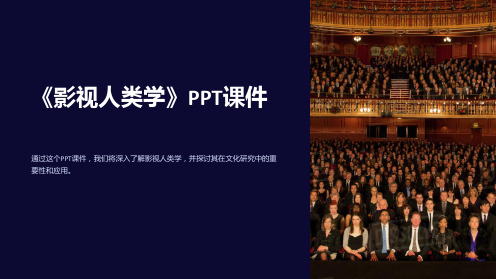
通过这个PPT课件,我们将深入了解影视人类学,并探讨其在文化研究中的重 要性和应用。
第一部分:介绍影视人类学
影视人类学是什么?
从人类学的角度解析电影和电视剧,探究其与人类文化的关系。
影视人类学的特点和重要性
了解影视人类学的研究方法和独特视角,以及其对文化研究的贡献。
影视人类学的发展历程
影视文化创意的营销
探索影视文化创意在广告营销中的创新运用和商业化开发。
第四部分:国际视野下的影视人类学
1
影视人类学在国际中的地位
介绍影视人类学在国际学术界的影响力和研究方向。
2
影视人类学与全球化的关系
讨论影视人类学在全球化背景下的发展,并探寻其对文化多样性的贡献。
结束语
展望影视人类学的未来前景,并总结本课程的重点和学术动态。
回顾影视人类学在学术领域的发展历史,以及相关的重要研究成果。
第二部影像、声音、文字等基本元素,
影视寓言学
2
探索其在不同文化背景下的意义和解 读。
研究影视作品中寓言的定义、形式以
及与文化之间的关联。
第三部分:影视文化创意
影视故事创作
探讨影视故事的特点、要素以及叙事模式和传达手段。
影视人类学专业
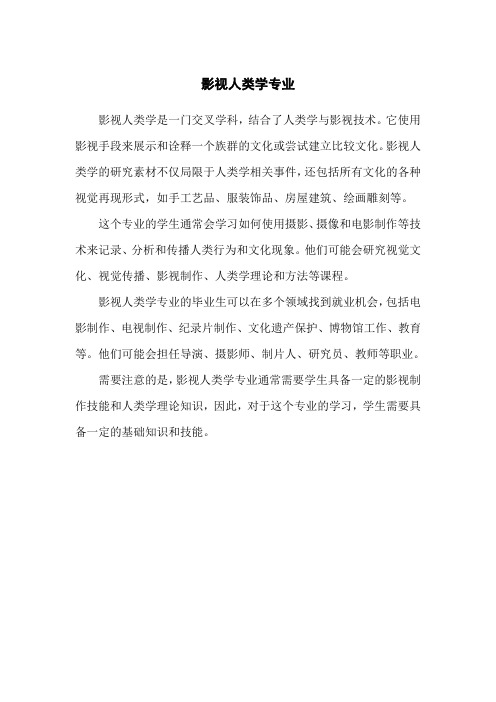
影视人类学专业
影视人类学是一门交叉学科,结合了人类学与影视技术。
它使用影视手段来展示和诠释一个族群的文化或尝试建立比较文化。
影视人类学的研究素材不仅局限于人类学相关事件,还包括所有文化的各种视觉再现形式,如手工艺品、服装饰品、房屋建筑、绘画雕刻等。
这个专业的学生通常会学习如何使用摄影、摄像和电影制作等技术来记录、分析和传播人类行为和文化现象。
他们可能会研究视觉文化、视觉传播、影视制作、人类学理论和方法等课程。
影视人类学专业的毕业生可以在多个领域找到就业机会,包括电影制作、电视制作、纪录片制作、文化遗产保护、博物馆工作、教育等。
他们可能会担任导演、摄影师、制片人、研究员、教师等职业。
需要注意的是,影视人类学专业通常需要学生具备一定的影视制作技能和人类学理论知识,因此,对于这个专业的学习,学生需要具备一定的基础知识和技能。
影视人类学课件
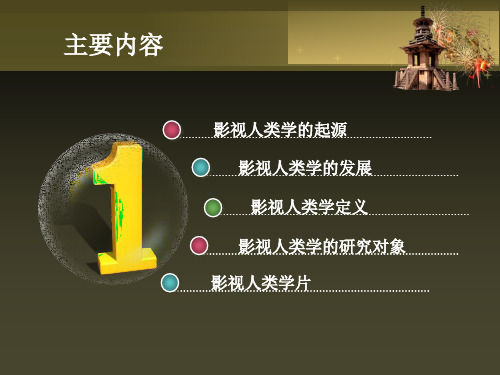
三、人类学片的研究价值 在很多情况下, 一幅画的作用可以胜过一本书。因为即使我们的文字描述能力再高超, 我们还是无法让读者身临其境地感受我们所描述的一切, 在这种情况下,影像的作用明显要比文字重要。人类学片的学术价值就在于它能够以影像的形式反映人类学研究对象。有学者将人类学片称为“全息民族志”, 这种称呼的准确性有待商榷, 但是在一定的程度上, 人类学片确实类似于“全息民族志”。
四、人类学片的教育功能 人类学片的教育功能有大众科普教育和人类学专业教育两个层次。普及科学知识, 提高民众的科学文化素质, 所包含的内容是很广泛的。其重要内容之一, 就是普及历史知识, 使人们了解社会发展规律, 用历史唯物主义武装头脑。人类学片在这方面具有它独到的直观教育的作用。如人们通过观看我国摄制的《苦聪人》、《凉山彝族》、《西藏封建农奴制度》等分别反映原始公社制、奴隶制和封建农奴制等不同社会形态的影片, 可以看见书本上见不到的“活化石”, 犹如学习了一部人类社会发展历史, 从而加深了对已经消失了的古代社会的理解。
在英语里,影视人类学的学科名称比较一致,叫做Visual Anthropology,在西方国家中通用。visual在英语中有“视觉的”、“看得见的”、“形象化的”等含义。Visual Anthropology可以理解为“可视的人类学”,或者“形象化的人类学”,《视觉人类学》。这个术语的出现很晚,大约在20世纪60年代后期才问世 。
二、交流民族文化。“人类学片能够将某一民族的文化信息提供介绍给另一民族, 使不同文化类型民族的人们通过影片了解彼此的文化, 并相互学习可供借鉴、吸收的文化知识、经验、技能。 文化交流对民族文化的发展至关重要。民族文化的发展一方面需要继承和弘扬本民族优秀的文化遗产和传统文化, 否则将失去文化根基; 另一方面要不断借鉴、吸收外来的优秀文化, 否则, 长期稳定的历史文化积淀将会愈趋封闭、保守, 失去发展的活力。
影视人类学概述

被认为是早期人类学片的经典之作,并被认为是人类
学电影的诞生之作。后来,分别在1926年和1934年,弗来贺提还发行了有关萨摩亚群岛的
《莫亚那--黄金时代的浪漫曲》(Moana-A Romance of the Golden Age)和有关爱尔兰
类学家在拍摄过程中应当保持一种客观、超然或客位的态度来反映被拍摄对象,并避免在
人类学片中带入拍摄者的情感和偏见或避免影响被
拍摄者。在20实际60年代以前,西方的人类学界,在影视人类学领域,人们就是持这种思
想来指导人类学片的拍摄的。
在影视人类学介绍到中国之初,中国的人类学家在进行影视人类学的理论研究时,
1901年,斯宾塞(Baldwin Spencer)在澳大利亚拍摄了袋鼠舞和祭雨的仪式。
1904年和1907年,伯奇(Rudolf Poch)分别在新几内亚和西南非拍片。
1908-1910年,汉堡南海考察队在密克罗尼西亚和美拉尼西亚拍摄了土风舞等内容。
1912年,格斯顿.梅里斯(Gaston Melies)在塔西提和新西兰拍片。
在台湾埔里乡村汉族的传统文化。 80年代,美国的
卜道在受聘为"国立台湾大学"的人类学系教师后,带领学生拍摄了赛夏族的朝拜矮灵的祭
祀活动。 1984年,胡台丽教授拍摄了记录排湾族"五年祭"的人类学片。 1997年,胡台丽
教授拍摄《穿过婆家村》,记录了台湾乡村社会的
变迁。
在90年代,还有以王慰慈女士、李道明以及井迎兆、李泳泉等为代表的一批人类学
力拍摄和播出反映少数民族生活为题材的纪录片,例如《丝绸之路》、《话说长江》、《
影视人类学名词解释
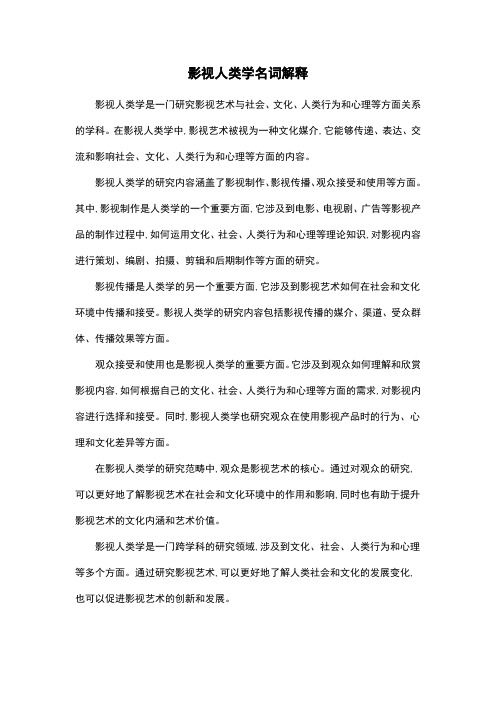
影视人类学名词解释
影视人类学是一门研究影视艺术与社会、文化、人类行为和心理等方面关系的学科。
在影视人类学中,影视艺术被视为一种文化媒介,它能够传递、表达、交流和影响社会、文化、人类行为和心理等方面的内容。
影视人类学的研究内容涵盖了影视制作、影视传播、观众接受和使用等方面。
其中,影视制作是人类学的一个重要方面,它涉及到电影、电视剧、广告等影视产品的制作过程中,如何运用文化、社会、人类行为和心理等理论知识,对影视内容进行策划、编剧、拍摄、剪辑和后期制作等方面的研究。
影视传播是人类学的另一个重要方面,它涉及到影视艺术如何在社会和文化环境中传播和接受。
影视人类学的研究内容包括影视传播的媒介、渠道、受众群体、传播效果等方面。
观众接受和使用也是影视人类学的重要方面。
它涉及到观众如何理解和欣赏影视内容,如何根据自己的文化、社会、人类行为和心理等方面的需求,对影视内容进行选择和接受。
同时,影视人类学也研究观众在使用影视产品时的行为、心理和文化差异等方面。
在影视人类学的研究范畴中,观众是影视艺术的核心。
通过对观众的研究,可以更好地了解影视艺术在社会和文化环境中的作用和影响,同时也有助于提升影视艺术的文化内涵和艺术价值。
影视人类学是一门跨学科的研究领域,涉及到文化、社会、人类行为和心理等多个方面。
通过研究影视艺术,可以更好地了解人类社会和文化的发展变化,也可以促进影视艺术的创新和发展。
《2024年影视人类学的脉络、路径和前瞻》范文

《影视人类学的脉络、路径和前瞻》篇一一、引言影视人类学是借助影视媒介与技术的力量,研究人类文化的科学。
随着科技的飞速发展,影视技术在人类学研究中的角色越来越重要,从而产生了影视人类学这一交叉学科。
本文将全面阐述影视人类学的起源、发展脉络及当前的应用领域,同时对未来可能的发展路径和前瞻性应用进行深入探讨。
二、影视人类学的起源与发展脉络1. 起源:影视人类学的诞生源于对人类学传统研究方法的探索和补充。
起初,学者们利用电影、摄影等影像技术来记录、研究和展示特定群体的生活和文化。
这些影像资料不仅为学术研究提供了丰富的素材,还为人们提供了了解不同文化的窗口。
2. 发展脉络:随着技术的进步,影视人类学逐渐发展成为一门独立的学科。
从最初的简单记录到现在的深度解读,影视人类学已经形成了自己独特的研究方法和理论体系。
在研究内容上,影视人类学关注文化传承、社会变迁、民族关系等议题;在研究方法上,影视人类学注重实地拍摄、深度访谈、影像分析等手段。
三、影视人类学的研究路径1. 田野调查与拍摄:影视人类学研究的重要手段之一是田野调查与拍摄。
通过实地拍摄、采访等手段,收集有关研究对象的文化、习俗、生活方式等资料。
这些资料为后续的影像制作和分析提供了基础。
2. 影像制作与传播:在收集到足够的资料后,研究者需要运用专业的影像制作技术,将资料转化为具有学术价值的影像作品。
这些作品不仅可以在学术会议上展示,还可以通过网络等媒介进行传播,让更多人了解不同的文化。
3. 深度分析与解读:通过对影像作品的深度分析和解读,研究者可以更深入地了解研究对象的文化内涵、社会变迁等议题。
这些分析结果可以为学术研究提供新的视角和思路。
四、影视人类学的应用领域1. 文化传承与保护:影视人类学在文化传承与保护方面发挥了重要作用。
通过记录和展示不同文化的特点和价值,帮助人们更好地了解和尊重不同的文化传统。
2. 社会变迁与民族关系:影视人类学还可以研究社会变迁和民族关系等问题。
学习影视人类学课程后的收获和建议

学习影视人类学课程后的收获和建议影视人类学是一门新兴的学科,它的核心在于研究人类对于电影、电视等影像媒介的各种文化、社会、心理和感性反应。
学习影视人类学的过程中,你可能会有以下收获和建议:收获:1. 更深入地理解人类文化:通过对于电影和电视的研究,可以更好地理解人类思维、文化、信仰和价值观。
2. 扩展视野:学习影视人类学不仅有利于了解西方文化中的电影、电视文化,也可以探究本地文化中电影、电视文化的地位和影响。
同时,学习过程中也会涉及到其他海外文化的内容,有益于拓宽我们的视野。
3. 普及学术研究方法:影视人类学是一门学术性很强的研究学科,在学习过程中,需要了解和应用许多学术研究的方法和工具,有助于提高我们的学术研究能力。
建议:1. 多看电影、电视:为了能够更好地学习和理解影视人类学的内容,我们需要多看一些电影、电视节目,并对它们的表现手法、故事情节、人物塑造等进行分析,有助于提升我们对于影像文化的敏感度和分析能力。
2. 培养阅读习惯:阅读是学习任何一门学科的关键,也是学习影视人类学必不可少的部分。
我们需要精读教材,了解名词、概念的含义和应用;同时还应该进行大量的阅读和文献调研,探究电影、电视等影像媒介的历史、现状、发展趋势和影响等。
3. 参与讨论和互动:学习影视人类学不仅仅是课本知识的积累,还需要参与各种讨论和互动,以拓宽视野、加深理解和提高思考能力。
可以参加学生讨论小组,与同学交流,也可以上网社区和论坛自由地发表自己的观点和看法。
4. 关注前沿研究:影视人类学是一个新兴领域,新的研究成果和分析方法往往会引起学界的高度关注和争论。
我们需要关注最新的研究成果和前沿研究方向,了解该领域目前的发展情况和研究现状。
《2024年影视人类学的脉络、路径和前瞻》范文

《影视人类学的脉络、路径和前瞻》篇一一、引言随着科技的快速发展,影视学和人类学日益交叉融合,催生出了一种全新的研究领域——影视人类学。
本文将简要概述影视人类学的发展脉络、分析其主要的探索路径,并对该领域的未来前景进行前瞻性探讨。
二、影视人类学的脉络1. 起源与发展影视人类学的起源可以追溯到电影和摄影技术的出现。
早期的人类学家利用电影和摄影技术记录和展示人类社会的各种文化现象,为人类学研究提供了新的方法和视角。
随着科技的不断进步,影视人类学逐渐发展成为一门独立的学科。
2. 理论支撑影视人类学以人类学理论为基础,结合电影、电视等影视技术,对人类社会、文化、历史等方面进行深入的研究。
其理论支撑包括文化相对论、社会结构理论、符号学等,这些理论为影视人类学提供了丰富的理论依据和研究方法。
三、影视人类学的路径1. 实地拍摄与记录影视人类学的研究方法之一是实地拍摄与记录。
研究者通过深入到研究对象所在的社区或地区,利用摄影机、录音机等设备记录当地的生活方式、文化传统、风俗习惯等,从而获取丰富的一手资料。
2. 影像分析与解读在获取了一手资料后,研究者需要对影像进行深入的分析与解读。
这包括对影像内容的分类、对比、归纳等,以及对影像中符号、象征等元素的解读。
通过这些分析,研究者可以更深入地了解研究对象的文化特征和社会结构。
3. 跨学科合作与交流影视人类学的发展离不开跨学科的合作与交流。
研究者需要与人类学、社会学、传播学等多个学科的研究者进行合作与交流,共同探讨和研究相关问题。
此外,影视人类学者还需要具备电影制作、视觉艺术等方面的技能,以便更好地运用影视技术进行研究和传播。
四、影视人类学的前瞻1. 技术发展与创新随着科技的不断发展,影视人类学将会有更多的技术创新。
例如,虚拟现实技术可以为研究者提供更真实的实地拍摄体验;人工智能技术可以辅助影像分析与解读等。
这些技术的发展将为影视人类学的研究提供更多的可能性。
2. 跨文化传播与交流随着全球化的推进,跨文化传播与交流日益频繁。
《2024年影视人类学的脉络、路径和前瞻》范文

《影视人类学的脉络、路径和前瞻》篇一一、引言影视人类学是运用电影、电视等影像手段,结合人类学理论和方法,研究人类社会文化现象的一门新兴交叉学科。
本文将概述影视人类学的发展脉络、路径和前瞻,探讨其在全球化时代的重要性,并分析未来发展的趋势和挑战。
二、影视人类学的脉络(一)起源与发展影视人类学起源于20世纪初的民族志电影和纪录片。
随着电影、电视技术的不断发展和普及,以及人类学研究方法的不断创新,影视人类学逐渐形成了一门独立的学科。
在发展过程中,影视人类学不断吸收人类学、社会学、文化学等学科的理论和方法,形成了独特的理论体系和研究方法。
(二)国内外发展现状国内外影视人类学发展存在差异。
国内影视人类学研究起步较晚,但近年来发展迅速,已成为研究民族文化、民俗风情、社会变迁等领域的重要手段。
国外影视人类学研究则更为成熟,涉及领域广泛,包括人类行为、文化传承、社会发展等。
三、影视人类学的路径(一)理论路径影视人类学以人类学理论为基础,结合电影、电视等影像手段,通过观察、记录、分析和解读人类社会文化现象,探讨其背后的深层含义和价值。
在理论路径上,影视人类学强调跨学科合作,借鉴其他学科的理论和方法,不断丰富和完善自身理论体系。
(二)实践路径影视人类学的实践路径主要包括田野调查、影像拍摄和后期制作等环节。
田野调查是影视人类学的基础,通过对研究对象进行实地考察和访谈,了解其社会文化背景和现实情况。
影像拍摄则运用电影、电视等影像手段,记录和呈现研究对象的生活状态和行为方式。
后期制作则是对拍摄的影像进行剪辑、配音、配乐等处理,使观众能够更好地理解和感受研究对象的真实情况。
四、影视人类学的前瞻(一)发展趋势随着科技的不断进步和社会的快速发展,影视人类学将面临新的挑战和机遇。
未来,影视人类学将更加注重跨学科合作,借鉴其他学科的理论和方法,不断拓展研究领域和深度。
同时,随着数字化和网络化技术的发展,影视人类学将更加注重数字化影像的采集、处理和传播等方面的发展。
什么是影视人类学

什么是影视人类学A什么是影视人类学影视人类学是人类学的分支学科之一,旨在用人类学的理论与方法贯穿纪录片电影的摄制;或者说,影视人类学是以影视手段表现人类学原理,记录、展示和诠释一个族群的文化或尝试建立跨文化比较的学问。
在人类学的教学与研究中,照片的拍摄、分析和民族志电影或录像最为常见。
在以文字作品为主流的人类学学术界,影视作品一直处于辅助性的位置,这显然和重文字轻图像的人类学传统相关。
然而,人类学家发现,有别于文字撰写,影视方法通过镜头所建构的图像可以寻求对文化的另一种理解形式。
而且,影视表现可以方便地实现人类学者一读者(观众)一当地人三者之间的直接交流,特别是把人类学思想反馈给那些异文化或没有书写符号的当地人。
文本与影视这两种类型的民族志实践具有相通性,因此影视人类学片也称为民族志电影。
B民族志电影的特点一一文字与影视合璧报告直到20世纪30年代,贝特森和米德将电影和照片运用到人类学研究中去。
他们认为,电影可以实现文字调查报告不能表现的东西。
1936—1939年,贝特森和米德使用摄影手段补充他们巴厘岛进行有关文化与性格的田野研究报告。
此次田野调查结束后的1932年,他们配合大量照片出版了两部著作。
此外,他们将拍摄的22000英尺16毫米胶片素材剪辑成《巴厘跳神与舞蹈》、《巴厘与新几内亚的儿童竞争》、《一个巴厘人的家庭》、《一个新几内亚婴儿的出生》等6部影片。
因此,米德和贝特森在巴厘岛关于文化和民族性的田野工作,因影像的介入使得再现栩栩如生的人物性格与表现过程成为可能。
并且,他们使影像作品首次成为人类学研究与成果报告的重要组成部分。
C拍摄原则及其实践1.为人类学的影片影视人类学的对象和人类学是一致的。
其目的都在于应用学科理论解释某种文化或行为。
多种方法的民族志田野工作经验及其田野成果的再现方式可以获得对于该族群和文化的重要综观。
保罗?霍金斯则认为,民族志电影在以下领域扮演了独特的角色:•1大学本科教学;•2文化材料档案;•3研究项目的设计和提出;•4探索性的田野工作;•5使人类学引起更多公众的注意。
- 1、下载文档前请自行甄别文档内容的完整性,平台不提供额外的编辑、内容补充、找答案等附加服务。
- 2、"仅部分预览"的文档,不可在线预览部分如存在完整性等问题,可反馈申请退款(可完整预览的文档不适用该条件!)。
- 3、如文档侵犯您的权益,请联系客服反馈,我们会尽快为您处理(人工客服工作时间:9:00-18:30)。
Anthropologic/Ethnologic Documentary
• “人类学纪录片‛是科学和艺术形式的一种结合方式,是 现代文明的产物。好像它的外在表现形式是影视纪录片, 但是传播的内容确是人类学中各个群体的生存状态的史料, 有点像国内的精英纪录片。就内容而言,人类学纪录片是 研究人类的科学成果、理性的,属学术成果,在这个意义 上,与人类学书面著作等同,而与一般纪录片有异。从表 述形式来看,人类学纪录片又是鲜活的、形象的,与人类 学书面著作的表述方式完全不同,而与一般纪录片相同。
4
人类学/民族学纪录片 Anthropologic/Ethnologic Documentary
人类学纪录片是人们运用影视手段,旨在研 究人类学和体现人类学研究成果而拍摄的 纪录片
1. 目的的表述,是为了研究人类学和体现人类学的研究成果, 这是人类学纪录片的本质,研究是出发点,研究指导拍摄。 2. 运用影视手段,影视手段是工具,是表达人类学研究内容 的重要媒体 3. 内容的表述,人类学纪录片的内容是人类学研究和人类文 化研究,它包括人类的生存状态、生活方式、人种繁衍、 组织规则、宗教信仰、社会结构、文化模式等等。 (陈刚,2001)
《影视人类学原理》
9
Paul Hockings
• 悉尼大学文学士;多伦多大学文学硕士; 加利福尼亚大学博士 • 语言:英语 法语 德语 • 研究领域 ● 拉丁 ● 记录片 ● 印度社会与历史 ● 影视人类学 ● Badaga民族研究 • 资深的人类学学者,是美国Illinois大学的 名誉教授,也是国际刊物《视觉人类学》 的主编。研究领域之一是南印度的Badaga 民族研究。他多年任教于美国加利福尼亚 大学洛杉矶分校及伊利诺斯州大学,教授 人类学及影片制作。
(/shownews.asp?newsid=10997)
人类学/民族学纪录片
• 人类学片是在人类学理论指导下,综合运用人类学研究的 科学方法和影视学的表现手段,对人类文化进行观察和研 究,所取得成果的形象化表述。(张江华,2000)
6
人类学纪录片的表现对象 • 人类的文化 • ‚向属于一种文化的人们解释属于另一种文化的 人们的行为‛(戈德施莱特,1975) 人类学纪录片的作用 • 当事件过于复杂,速度过快或太小,以至于人用 肉眼或文字书写无法把握的时候,它们作为记录 事件的工具而存在 • 由于人们的很多行为即将消逝,或者理论所涉及 的事物已不复存在的时候,它作为一种为了后代 进行抢救性记录的方式而存在 • 用于共时性跨文化的对比和历史性的文化变迁研 究(布里加德, Emilie De Bergard)
12
巴厘跳神与舞蹈 Trance & Dance in Bali
• The clip is from a sequence at the end of the ceremony, and focuses on an older woman who unwittingly went into a trance during the ceremony. She wasn't one of the dancers, but Mead picked up on her. The woman is trying to pull herself out of the trance. • FILM SOUNDTRACK (MEAD): "Here is an old woman, 'unwilling' to come back to herself, 'remembering her death' -- until finally the priest brings special offerings to the spirit that possesses her, to persuade it to leave her body. The priest makes his offering of flowers and [ ? ] -on the ground -- while she continues to dance [ ? ] -- At last, she holds out her hands for the holy water, a sign she is willing to come out of the trance."
读书报告 影视人类学
李知宇
华南师范大学2007级博士生 2008-05-28
Visual Anthropology of the Trance Music
• 《影视人类学原理》 • 《原始的激情:视觉、性欲、民族志与 中影像与影视手段表现人类学原理, 记录、展示和诠释一个族群的文化或 尝试建立比较文化的学问(庄孔韶, 2004)
• 电子邮件:paulh@.hk
10
本尼迪克特 (Ruth Benedict 1887-1948)
《玛格丽特· 米德和鲁思· 本尼迪克特》
米德 (Margaret Mead 1901- 1978)
11
米德和贝特森 Margaret Mead & Gregory Bateson
• • • • 《巴厘跳神与舞蹈》 《巴厘与新几内亚的儿童竞争》 《一个巴厘人的家庭》 《一个新几内亚婴儿的出生》
13
一个新几内亚婴儿的出生
The First Days in the Life of a New Guinea Baby (MEAD & Bateson, 1938)
• "As the picture opens you see the mother wiping the newborn baby off with a piece of grass skirt. She severs the cord and puts the placenta in a coconut shell. She holds the baby up again, wipes it, tosses it in the air, tosses it sideways, and tosses it over on an old grass skirt, while the old woman attendants pour water over it. • "Here you see the mother sitting, waiting for a piece of European cloth to be brought -- while the baby lies on the old grass skirt, on the ground, opening and shutting its hands, and crying, while the sunlight makes flecks on its body. • "The wet nurse has arrived; the wet nurse, who will later suckle the newborn. She flicks away the flies and protects the babies feet from the touch of scratchy sticks. • "More water is brought for the mother to bathe in, and she stands, only a very few minutes after the birth of the child, while cold water from the river is poured over her, as neighbor children watch. The wet nurse brushes the flies off the newborn child, and she nurses her own baby and smokes a cigar. • "The 'cloth' has been brought and they are ready now to go to the village.”
3
Wikipedia(维基)
• 影视人类学是文化人类学的一个子域。它是自20 世纪90年代中期由民族志摄影、影片的发展和研 究而来。尽管影视人类学有时可以与民族志影片 交替使用,影视人类学还包含对‚呈现‛的人类 学研究,如表演、博物馆、艺术和大众媒体的制 作和接受。
• Visual anthropology is a subfield of cultural anthropology that developed out of the study and production of ethnographic photography, film and since the mid-1990s, new media. While the term is sometimes used interchangeably with ethnographic film, visual anthropology also encompasses the anthropological study of representation, including areas such as performance, museums, art, and the production and reception of mass media. (/wiki/Visual_anthropology)
7
人类学纪录片的分类 • 提供研究用的纪录片断 • 用于人类学课程的教学片 • 供电视台播放或学术交流的具有 完整结构的作品
8
Principles of Visual Anthropology
Edited by Paul Hockings (2001,2007)
• 简介 文字训练中的影视人类学 • 民族志影片与电影 民族志电影史;作为文化纪录的故 事片;麦卡蒂规则以及如何超越该规则 • 新近民族志电影的一些动向 新近民族志电影的一些动 向摄影机和人;观察电影;跨越观察法的电影;都市电影 的理念与事件自然现象的电影拍摄:基本战略;跨越观察 法的电影 • 影视人类学与历史 民族志电影和历史;电影中的文化 重建影视在考古工作中的作用;人类学研究中的民族志摄 影;我们的图腾先祖与疯狂的灵媒 • 电影和录像的一些专门用法 摄影与影视人类学;磁带 录像:人类学观察与分析的新技术;体态行为的拍摄;文 化形式分析的视听工具;在民族学研究中使用影片 • 人类学信息透视 电视民族志——美国、英国、日本和比 利时电视中的人类学;第一家影视资料馆;记日本电视台 民族志电影的制作方法关于事实的言说 • 影视人类学的未来 自我意识在部落成员间引发的恐慌; 影视记录,人类知识和人类未来;结论:民族志电影及人 类学理论
